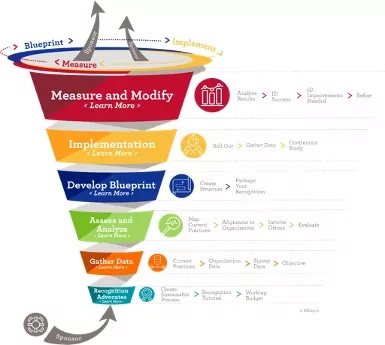- October 10, 2022
- Posted by: Hillary Feder
- Category: Company Culture, Employee Engagement

Fourth quarter is synonymous with determining next year’s business objectives and planning how to achieve them. Thoughts typically revolve around IT hardware updates and new SaaS initiatives, facilities projects, entering new market segments, and the like. A recognition system is typically low on the list—if it makes it at all.
If you’re wondering whether your organization has a recognition system or if it does, why it needs to be reviewed and updated, read on for nuggets that build and strengthen recognition practices and systems.
Much thought goes into planning and designing a new recognition system, followed by scrutiny during the first year or two to monitor “how it’s going”. However, once it’s running smoothly, it can easily slip into auto pilot mode, void of a process for identifying needed adjustments to keep it viable.
A recognition system is one of six key elements that shape the employee experience, which in turn affects your client experience, ultimately impacting your bottom line. Simply put, a recognition system:
- provides positive feedback for results-driven accomplishments;
- demonstrates appreciation for your team in an organized, well thought-out approach that is meaningful to your team; and
- reflects your business objectives, values and brand.
Without a robust recognition system, organizations shoot from the hip with inconsistent recognition practices and quite possibly overlook accomplishments that merit acknowledgement.
The three key components of a recognition system include:
- Formal recognition—contributions based on results metrics (service recognition, sales awards)
- Informal recognition—achievement of group milestones (in larger initiatives)
- Day-to-day recognition—professional and personal events (incremental advancement in a skill, going above and beyond, a promotion, welcoming a child, acknowledging loss, or special achievement in a hobby/sport)
A system ensures that employees are consistently recognized for their contributions, specifically what is recognized and how. In the most effective systems, recognition parameters align with business objectives, core values, and branding. Documentation provides the organization a toolbox for success, which results in greater engagement, increased productivity, and lower voluntary turnover. In essence, it prepares the organization for recognition from all directions: from leaders and managers to direct reports; between work colleagues/peers; and from direct reports to a manager.
A system should also take into account that not all recognition calls for an “award” or “thing”. It should spell out smaller moments that require a private pat on the back, acknowledgement through a hand-written note, or a public acknowledgement—again for consistency. These more frequent moments add up to big impact. However, without a system, they simply may be overlooked.
While it’s easy to focus attention on the item being presented, don’t underestimate the importance of the delivery to create a personal connection. Two points to keep in mind here. First, people have varying levels of speaking/writing skills, so a coach can help them articulate a presentation that inspires an emotional connection. Secondly, recognition that’s delivered with more humanity and less technology scores higher on the meaningful scale, so balance the use of technology to streamline the process (email, automated standard messaging) with in-person recognition.
Why now?
Making your people a priority and seeing them as a key to your success is always important, but never so much as today. People are looking for a meaningful work experience, where they feel their contributions are valued. Proof that so many employees are just not feelin’ it abounds:
- Great Resignation leading to labor shortages
- Quiet Quitting (employees show, but don’t give what they’re able to)
- Controversy over workplace changes (virtual, hybrid, in-person)
Another influence worth considering is rampant burnout being expressed by employees who have struggled to weather the past 2 ½ years of turmoil. Recognition that provides opportunities to exhale and recharge are likely to be highly valued. Think PTO, spa services/visits.
Put time on your side
Achieving business objectives involve timelines and milestones. As you plan your major initiatives, plan how you will identify and recognize each stage as well as completion. Waiting until the 11th hour to address details usually undermines recognition effectiveness.
A perfect example: one of our med device clients came to us as the FDA approved their product. They wanted something the next week that provided a visual of the product, showed the testing that green lighted the FDA’s approval, and included the company name and date of the FDA approval. It took a few days to determine the right product and a few weeks to have it made. They either had to push back their celebration or hold the celebration and distribute the moment to several weeks later. Either way, the message appears to be: We aren’t prepared.
Recipient perception is everything
Thoughtful, meaningful recognition is not one-size-fits-all, but rather calls for a deep understanding of employee preferences paired with a detailed articulation of the accomplishment and how it benefited the presenter, the team, and/or the organization. Recognizing small improvements as well as big wins sustains engagement. Employees who are more frequently acknowledged reinforce their internal motivation to reach their own sense of purpose.
Developing a recognition system is no small task, and may require a team to create balance. If you’re interested in some support, we’re here to help. Let’s start a conversation. Call 800-742-6800 or email (hillary@ashillarys.com) today.
For individual recognition, find rewards that match your employees. A subscription to the Breadstick of the Month Club would mean much less to the employee with the gluten allergy.

